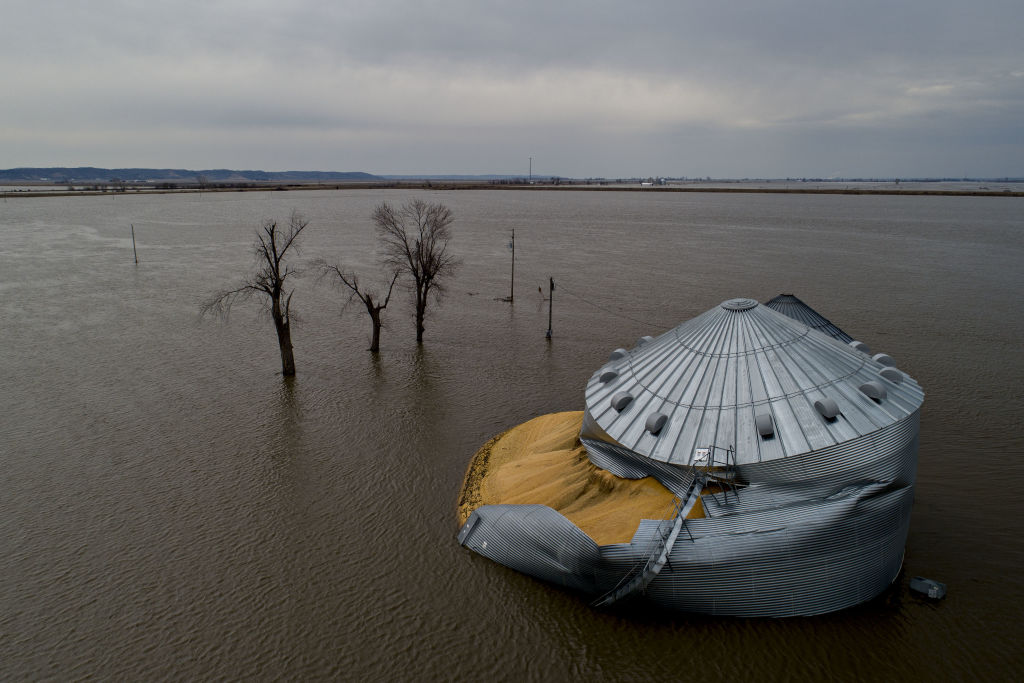
What’s behind the most significant inflation in decades? Read most news articles and you’ll hear a variation on a standard answer: a combination of supply chain challenges caused by the quick ramp up of the economy after COVID-19 lockdowns and substantial spending driven by consumers who saved up—and collected money from the government—while businesses were closed.
There’s no question that these two interrelated factors are driving prices higher, but beneath the headlines economists say that extreme weather events tied to climate change are also contributing to inflation. Across the world, climate-linked disasters have killed crops, disrupted energy supplies, and crippled transportation lines. Economists say that this reality will only worsen as the planet warms.
But the link between climate change and inflation doesn’t stop there. The trillions of dollars the public and private sectors need to spend to transition the world away from fossil fuels, not to mention regulations designed to increase the costs of carbon-intensive goods, are bound to shape the course of future inflation, and a debate has emerged about what the effects will be.
Extreme weather events
Last year, the U.S. experienced 20 weather and climate disasters that caused more than $1 billion in damage each, from tropical storms in Florida to drought in the west, according to the National Oceanic and Atmospheric Administration (NOAA). The costs that NOAA tallies include things like destroyed buildings and other property damage, but the economic implications of such disasters extend much further. To make it more concrete, I want to look at a few of the big climate-related disruptions from last year in closer detail.
The first that comes to mind is the winter storm in Texas that shut off power for some state residents for days on end last February and is estimated to have cost more than $100 billion. Across the state, many natural gas pipelines that were ill equipped to handle winter weather went offline. This not only shut off heat for many in Texas but also forced Gulf Coast petrochemical refineries—which produce three quarters of the country’s basic chemicals—to temporarily stop production. These chemicals are used to make everything from soda bottles to car bumpers. In the wake of the freeze, the U.S. lost 28% of its shipments of chemicals by railcar and prices of the basic chemical rose dramatically, according to a report from the Dallas Fed. That chemical shortage in turn contributed to shortages across a range of industries as well as price increases that were passed along to consumers. By mid-April, production had recovered—but prices remained high through the end of the year.
A version of this story first appeared in the Climate is Everything newsletter. To sign up, click here.
The wildfires that struck California last year also disrupted supply chains and drove up costs as key roads and railroads in the fire zone closed. To avoid fire hazards, truck drivers found themselves taking a circuitous route that added a day and a half of travel time to get from California to Salt Lake City, according to a story published in Supply Chain Dive. Taking longer routes means greater fuel usage, more labor expense and potentially disruptive delays for the manufacturers and retailers waiting for the product on the other end. The list could go on and on: cold weather harming orange crops in Florida, tornadoes destroying grain and poultry facilities, and lumber facilities shut down amid wildfires. All of this can lead to higher prices for consumers.
As the effects of climate change become more evident, so will the implications for inflation. “A greater incidence of physical risk can cause short-term fluctuations in output and inflation that amplify longer-term macroeconomic volatility,” Isabel Schnabel, a member of the executive board of the European Central Bank, wrote in a paper published by the International Monetary Fund last year. “Unless mitigation policies are more forceful, the risk of even larger climate shocks grows, with more persistent consequences for prices and wages.”
Policy
There’s no question that governments need to do more to combat climate change—to halt the extreme weather events that drive inflation, yes, but also just to save lives and keep society from collapsing. But even among those who agree on the urgent need for climate policy a debate has emerged about the inflationary effects of such rules and regulations.
At the most basic level, it’s easy to understand how climate policy might drive up prices. Indeed, the entire point of carbon pricing and regulatory schemes is to increase the costs of emitting carbon. And, because today’s economy largely runs on carbon-based fuels, these policies might mean higher prices of goods in the short term while manufacturers find less carbon intensive ways of doing business.
But it’s more complicated than that. A 2020 report from the European Central Bank argues that central banks can manage the effects of climate policy on inflation—so long as the transition is “orderly.” That is, central banks can use their tools to manage the increased cost of carbon-intensive energy if price rises are “modest but sustained” and “well-communicated—and anticipated by households and businesses.” On the other hand, a “disorderly transition” would be hard to manage and would create challenges for maintaining economic growth while also constraining inflation.
More Must-Reads From TIME
- The 100 Most Influential People of 2024
- The Revolution of Yulia Navalnaya
- 6 Compliments That Land Every Time
- What's the Deal With the Bitcoin Halving?
- If You're Dating Right Now , You're Brave: Column
- The AI That Could Heal a Divided Internet
- Fallout Is a Brilliant Model for the Future of Video Game Adaptations
- Want Weekly Recs on What to Watch, Read, and More? Sign Up for Worth Your Time
Write to Justin Worland at justin.worland@time.com